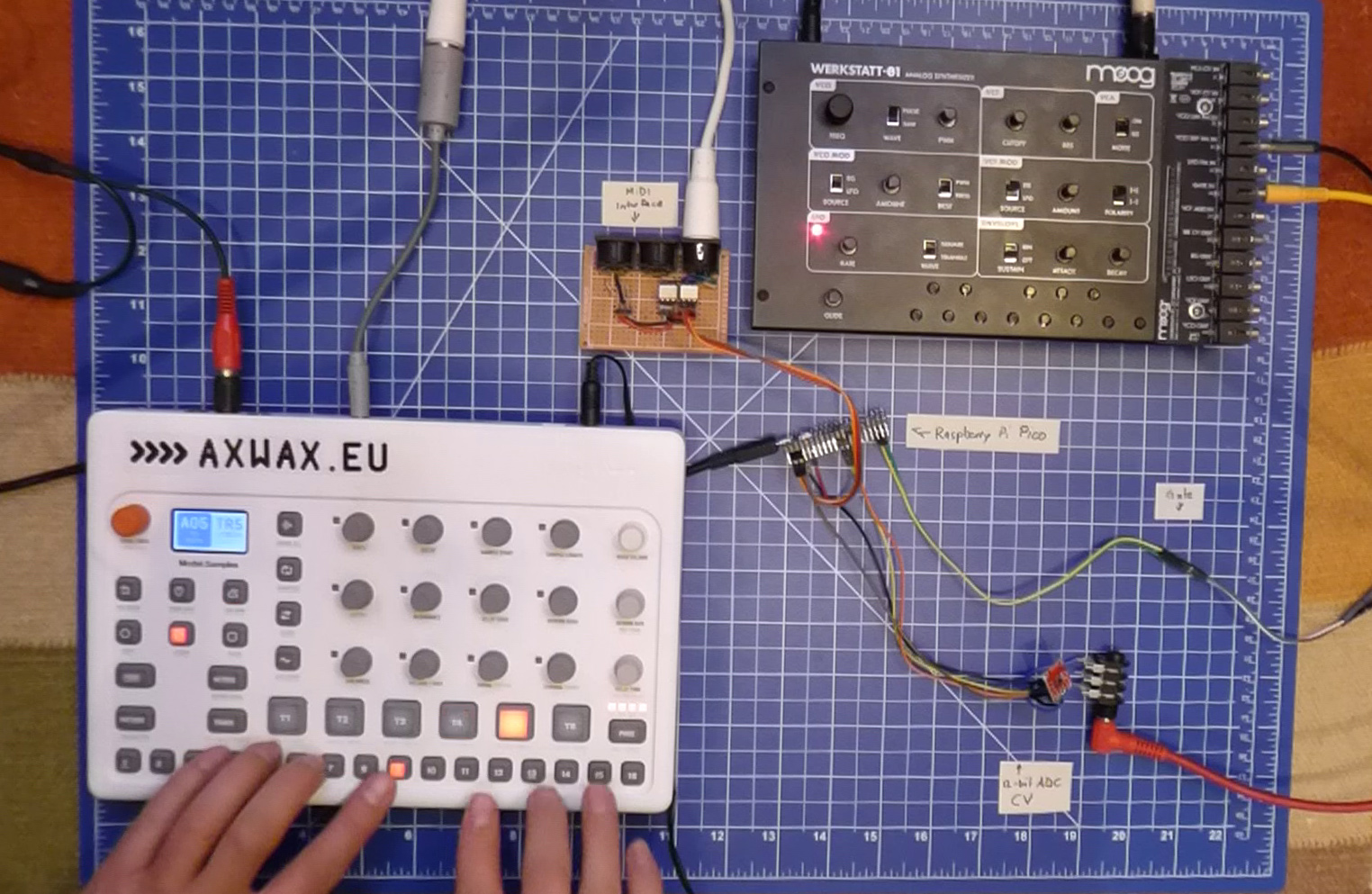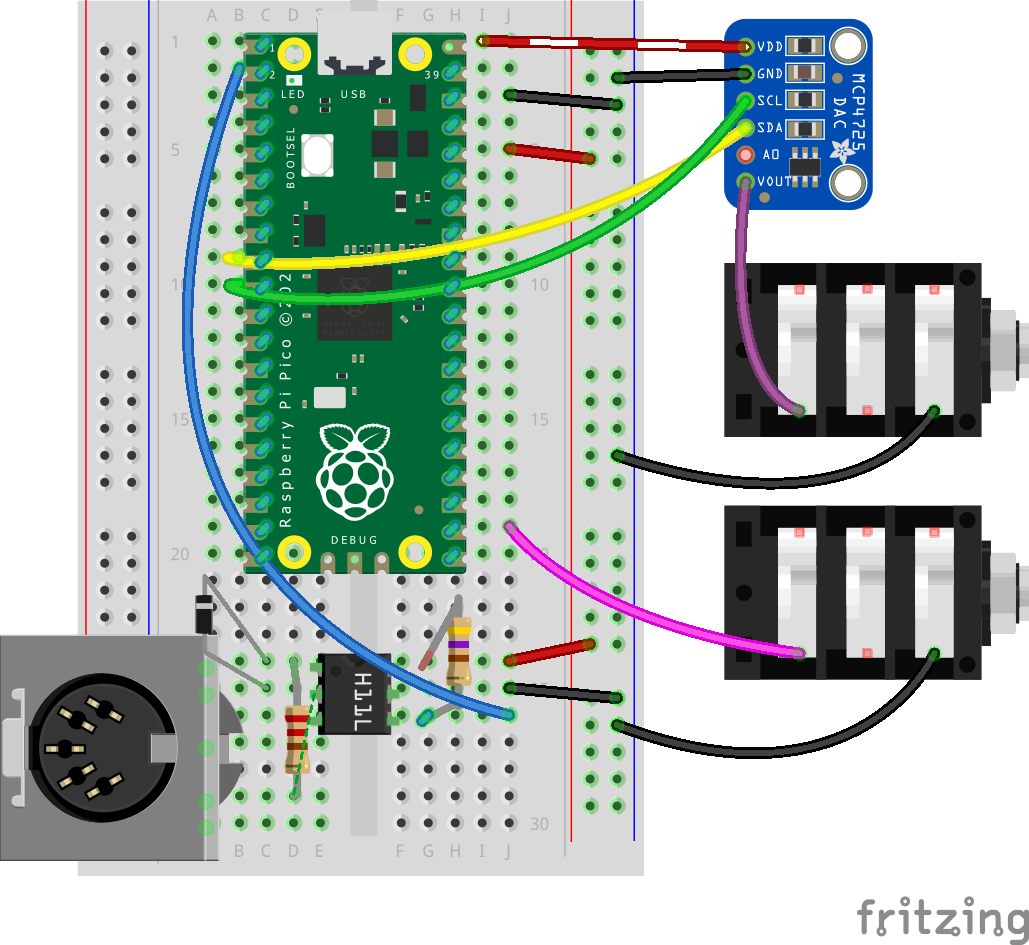This entry is part 1 of 2 in the series Raspberry Pi Pico as MIDI to CV converter
I’ve been toying with the idea of building a MIDI to CV converter for at least a decade. Now I’ve finally had a go using MicroPython on the Raspberry Pi Pico.
Here’s how I managed to control my Moog Werkstatt-01 over MIDI using the Pico, a handful of components and a MCP4725 12-bit DAC:
The Hardware
BOM
- Raspberry Pi Pico
- HC11L optocoupler
- 220Ω Resistor
- 470Ω Resistor
- small signal diode (eg 1N914)
- MCP4725 module
Circuit Diagram
The Code
The code is written in Micropython. Its only external dependency is the SimpleMIDIDecoder class by @diyelectromusic. You can download the latest version on GitHub here: SimpleMIDIDecoder.py.
This file contains hidden or bidirectional Unicode text that may be interpreted or compiled differently than what appears below. To review, open the file in an editor that reveals hidden Unicode characters.
Learn more about bidirectional Unicode characters
| # MIDI to CV converter for Raspberry Pi Pico and MCP4725 DAC by @AxWax | |
| # | |
| # Demo: https://www.youtube.com/watch?v=aGfQHL1jU4I | |
| # | |
| # This is heavily based on and requires | |
| # the SimpleMIDIDecoder library by @diyelectromusic, which can be found at | |
| # https://diyelectromusic.wordpress.com/2021/06/13/raspberry-pi-pico-midi-channel-router/ | |
| # | |
| # | |
| # Wiring: | |
| # serial midi input on GP1 (UART0 RX) | |
| # gate output: GP17 | |
| # | |
| # MCP4725 Pico | |
| # GND GND | |
| # VCC VBUS (5V) | |
| # SDA GP6 | |
| # SCL GP7 | |
| # VOUT is the CV output | |
| import machine | |
| import time | |
| import ustruct | |
| import SimpleMIDIDecoder | |
| # which MIDI note number corresponds to 0V CV | |
| lowest_note = 40; | |
| # create gate pin | |
| gate = machine.Pin(17, machine.Pin.OUT) | |
| gate.value(0) | |
| #create an I2C bus | |
| sda=machine.Pin(6) | |
| scl=machine.Pin(7) | |
| i2c = machine.I2C(1, scl=scl, sda=sda, freq=400000) | |
| # calculate 1mV: steps / max V / 1000 | |
| mv = 4096 / 5.1 / 1000 | |
| # calculate mV per semitone | |
| semitone = 83.33 * mv | |
| # DAC function | |
| def writeToDac(value): | |
| buf=bytearray(2) | |
| buf[0]=(value >> 8) & 0xFF | |
| buf[1]=value & 0xFF | |
| i2c.writeto(0x62,buf) | |
| # Initialise the serial MIDI handling | |
| uart = machine.UART(0,31250) | |
| # MIDI callback routines | |
| def doMidiNoteOn(ch, cmd, note, vel): | |
| global semitone | |
| writeToDac(int((note-lowest_note)*semitone)) | |
| gate.value(1) | |
| def doMidiNoteOff(ch, cmd, note, vel): | |
| global semitone | |
| gate.value(0) | |
| # initialise MIDI decoder and set up callbacks | |
| md = SimpleMIDIDecoder.SimpleMIDIDecoder() | |
| md.cbNoteOn (doMidiNoteOn) | |
| md.cbNoteOff (doMidiNoteOff) | |
| # the loop | |
| while True: | |
| # Check for MIDI messages | |
| if (uart.any()): | |
| md.read(uart.read(1)[0]) |
- Raspberry Pi Pico as MIDI to CV converter
- A second CV out for the Raspberry Pi Pico MIDI to CV converter




One Reply to “Raspberry Pi Pico as MIDI to CV converter”
Comments are closed.